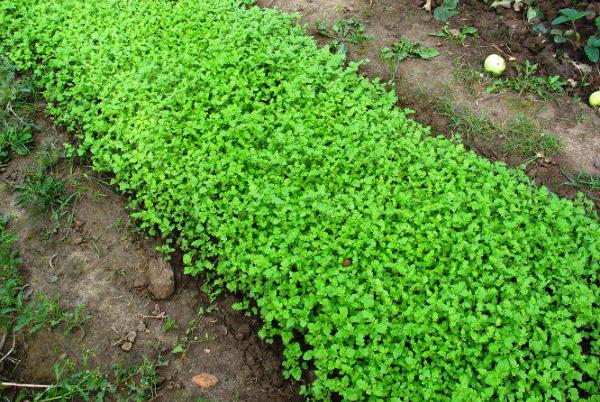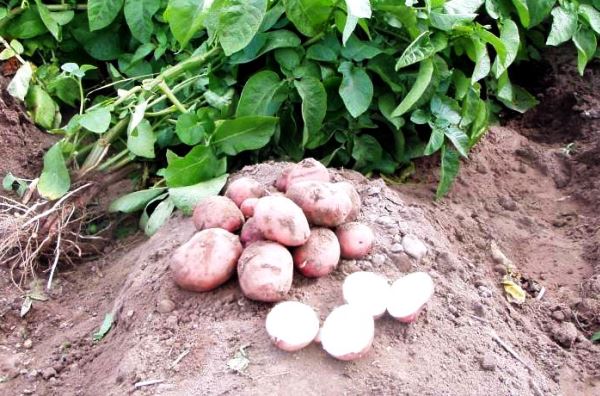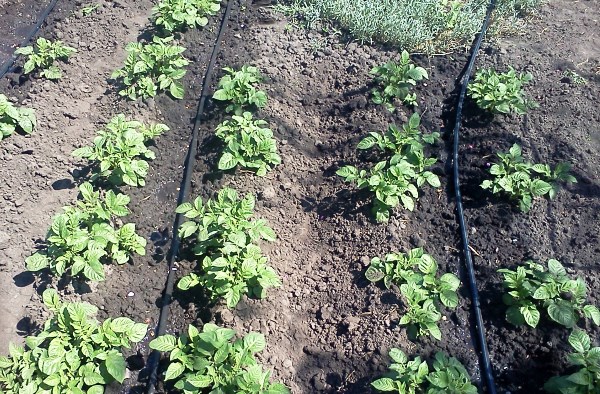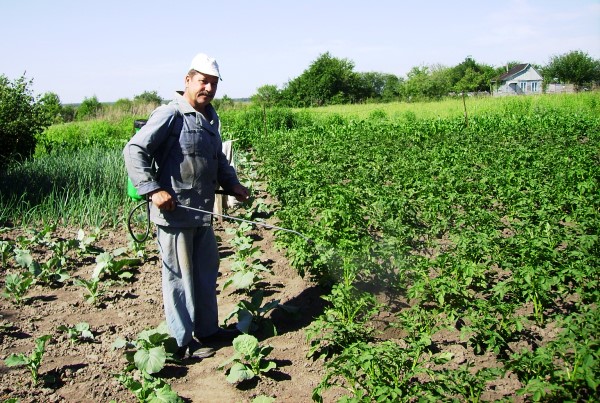How to protect potatoes from late blight
Potato late blight is the main disease that affects both plants and tubers. Statistical data indicate that about 10-15% of potato crop losses are associated with late blight. Sometimes the yield drops to 50%. Experienced summer residents and gardeners know that it is necessary to take timely measures in order to prevent this disease. Protecting potatoes from late blight is very important. What kind of disease is this, and what are the main methods to combat it?
Content
Causes and signs of late blight
The main reason for the development of potato late blight is pathogens - oomycetes (lower fungi). The incubation period of the fungus is 3-16 days, so the disease progresses very quickly. Their mycelium are found in potato seeds previously affected by late blight. Soil and plant debris are also major sources of disease. The likelihood of potato late blight disease increases with the presence of microorganisms in the seeds and soil. When the stems germinate, the disease in the form of released zoospores rises along with moisture along the soil capillaries, and the tubers are already infected from the tops.
The optimal conditions for the development of the disease are a certain temperature regime: + 15-25 degrees Celsius and humidity over 90%, especially with drip-liquid moisture. Potato late blight spreads quickly with dense planting of plants. Very often, the onset of the development of the disease is observed after the loss of thick dew. When the heat comes, the fungi slow down their spread. Late blight spots dry up, and new healthy leaves grow, thus rejuvenating the stems. So the heat will help fight the disease.
The main signs of the disease are dark spots on the leaves, which quickly spread throughout the plant. As a result, after a while, brown spots appear on the stem and the tissue dies off. If you look at the underside of the leaf, you can see the spores of the fungus in the form of a white bloom. The main difficulty is that these harmful spores are easily spread by wind or water in rainy weather. If you notice the symptoms of late blight of potatoes in time, then there is still a chance to save the crop. Late blight of potatoes after a few days can cause darkening, twisting and drying of the leaves. And the potato tubers themselves will become covered with hard spots and become a source of disease for neighboring tubers.
Prevention methods
There are several methods for preventing late blight of potatoes: choosing a site for planting, using potato varieties resistant to disease, processing with special preparations. Let's consider these methods in more detail.
Earlier it was said that soil becomes one of the main sources of late blight. Therefore, you should choose leveled fields for planting potatoes, since it is in the depressions (places with higher humidity) that there are foci of the disease. The soil must drain well and not be heavy. The place for the plantation or vegetable garden should be sunny and well ventilated. You also need to increase the distance between planting different nightshade crops to avoid infection. It is worth choosing varieties that are resistant to infection and observe seeding changes. It is impossible to grow the same crops in the same place for more than 4-6 years. The best precursors for potatoes will be perennial grasses, winter crops, flax, beets, and corn. If this is not possible, then you can sow the area with mustard or radish. These plants need to be cut down and buried in the soil.It has been proven that the risk of infection with a fungus can actually be reduced by 3 times, alternating planting potatoes in 2-3 years.
If you use already infected seed, then late blight disease is ensured. But how do you identify infected tubers? To do this, it is advised to warm up the planting potatoes for 10-15 days at a temperature of 15-18 degrees. Under such conditions, you can see the first signs of the disease and discard diseased seeds. Further, it is necessary to carry out treatment with some fungicides or preparations, which increase the resistance of potatoes against late blight. Among such agents are Immunocytofat, Agat-25K.
It is worth paying attention to varieties that are resistant to late blight. Among them are noted: Arina, Verb, Sante, Visa, Lazar, Tomich, Rozara, Oredezhsky and others. The listed varieties are not completely resistant to potato late blight, but they have varying degrees of susceptibility to the disease. There are varieties in which only the stems will not be infected, or only the tubers. It is important that some mutations may occur, which will reduce the resistance of the variety, or new strains of the disease may appear. As you can see, you cannot completely protect your crop from late blight disease by only choosing the right potato variety, but in this way you can reduce the rate of development of the disease and postpone the epiphytotic time. There is an option for planting early varieties of potatoes. The disease simply does not have time to completely hit the plant, and the crop will be saved.
Harvesting potatoes should be carried out in sunny weather, since high humidity contributes to the preservation of spores of the late blight fungus. It is important to dry the tubers well and prevent injury.
One of the methods of preventing the disease is the introduction of mineral fertilizers, namely potassium and phosphorus fertilizers. At the beginning of the development of the culture, it is worth increasing the dose of potassium by 2 times, and phosphorus by 1.5. In addition to potash and phosphorus fertilizers, wood ash can be applied as a top dressing. Pay close attention to the application of nitrogenous fertilizers. With an excess of nitrogen, the development of tubers is delayed, which leads to a greater susceptibility to diseases.
In order to promote the thickening of the skin of the potato, it is necessary to loosen the soil and mow the tops. Also for this purpose, the chemical preparation Reglon Super is used.
In dry and cool weather, do not water the potatoes by sprinkling, but only put the hose into the grooves. If you see diseased plants, they need to be cut and burned. Weeds can also create a favorable microclimate for the development of late blight. They can interfere with the uniform application of fungicides or harbor fungal spores.
Treatment
Potato late blight is an incurable disease, but measures can be taken against the development and spread of the disease. There is a specific treatment scheme for potatoes to prevent and control ailments. The first time it is necessary to carry out the treatment when the tops grow by 25-30 cm. In this case, it is recommended to use systemic preparations or mixtures. With a frequency of 10 days, it is worth spraying potatoes with a solution of copper sulfate, per 10 liters of water, 2 grams of vitriol. You can also spray plants with 1% Bordeaux liquid or copper sulfate solution (20 grams per 10 liters of water). Watering with manganese solution is allowed.
Already before the potatoes begin to bloom, it is worth carrying out the next processing. It is advised to use the drug Epin. If the weather and other conditions indicate to you that the degree of risk of the disease is low, then you can apply the protection of potatoes against late blight with resistance inductors: Silk, Krezacin, Immunocytofat.
After one to two weeks, it is recommended to treat with contact fungicides (for example, copper oxychloride, Efal, Ditan M-45).If spraying is carried out for prophylactic purposes, that is, the plants are not infected, the dose of the agent should be halved. It is important to remember that the fungus adapts to systemic fungicides.
If the potato is already infected, then Ridomil Gold MC, Oxykhom, Ridomil MC are used against the fungus. Processing can be carried out no more than twice with an interval of 10-14 days, but only until the flowering period. The Bravo remedy is used after the potatoes have faded. Spraying interval 7-10 days. At later stages, in order to fight the tuber with the disease, it is allowed to carry out the treatment with Alufit. Remember that even with a slight infestation of the tops, severe damage to the tubers is possible. Therefore, you should protect the foliage with a fungicide until it dies completely.
It is important to remember that if it rains after treatment, it must be repeated.
The people know perfectly well how to deal with late blight of potatoes. These methods are effective for use at any time of the growing season. It is recommended to spray the plants with a mixture of milk with a few drops of iodine. Good results are obtained by treating the stems with an infusion of arrows and chives. To prepare the preparation, grind the garlic in an enamel bowl and add water. After 12 hours, strain and spray the plants.
It is impossible to completely cure potatoes from late blight disease, but you need to fight it in order to preserve the potato crop.
Video "Late blight and protection against it"
The video tells about a serious disease of potatoes - late blight, about the causes and ways of dealing with it.








